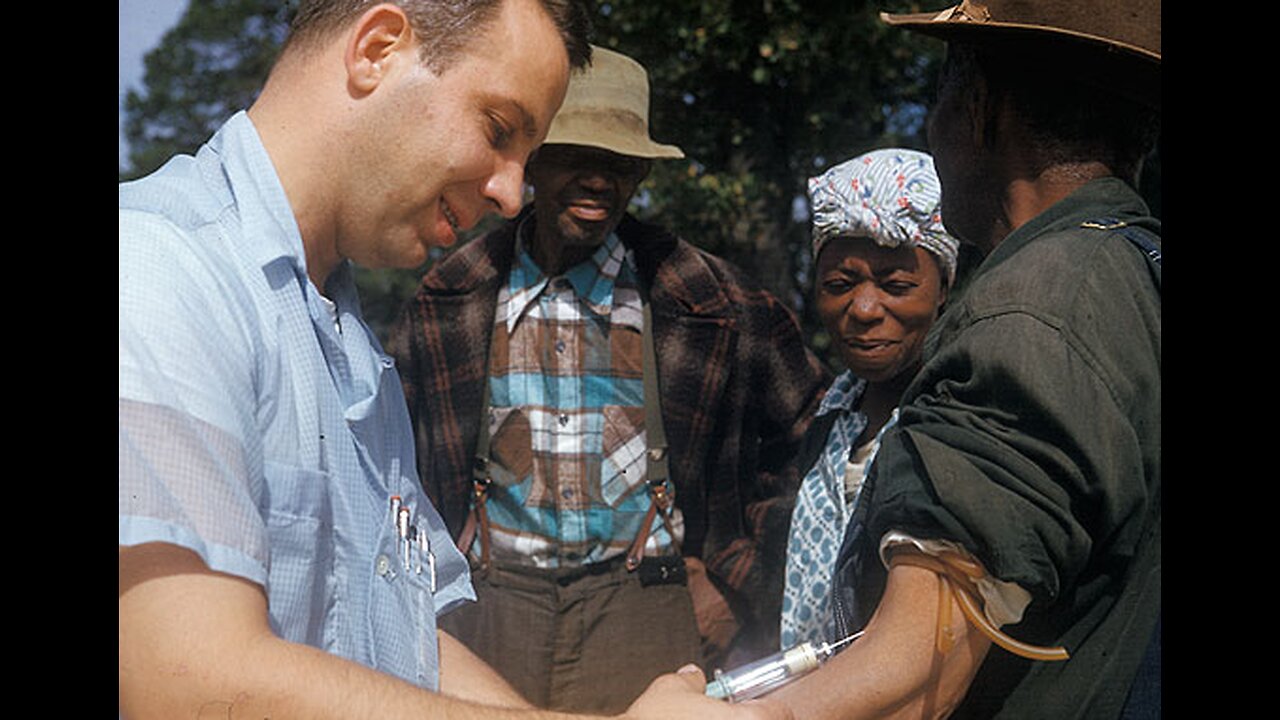Premium Only Content

Tuskegee Syphilis Experiment Revised
Tuskegee Syphilis Experiment explained with the help of photos and documentation. Courtesy, of the National Archives and Records Administration.
Tuskegee Syphilis Study
From Wikipedia, the free encyclopedia
Tuskegee Syphilis Study
Tuskegee-syphilis-study doctor-injecting-subject.jpg
A doctor draws blood from one of the Tuskegee test subjects
Dates 1932–1972
Locations Tuskegee, Alabama
Funding U.S. Public Health Service (PHS)
The Tuskegee Study of Untreated Syphilis in the Negro Male[1][2][3] (informally referred to as the "Tuskegee Syphilis Experiment," the "Tuskegee Syphilis Study," the "Tuskegee Study of Untreated Syphilis in the African American Male," the "U.S. Public Health Service Syphilis Study at Tuskegee," or the "Tuskegee Experiment") was an ethically unjustified study conducted between 1932 and 1972 by the United States Public Health Service (PHS) and the Centers for Disease Control and Prevention (CDC).[4][5] The purpose of this study was to observe the natural history of untreated syphilis. Although the African-American men who participated in the study were told that they were receiving free health care from the federal government of the United States, they were not.[6]
The Public Health Service started the study in 1932 in collaboration with Tuskegee University (then the Tuskegee Institute), a historically black college in Alabama. In the study, investigators enrolled a total of 600 impoverished African-American sharecroppers from Macon County, Alabama.[6] Of these men, 399 had latent syphilis, with a control group of 201 men who were not infected.[5] As an incentive for participation in the study, the men were promised free medical care, but were deceived by the PHS, who never informed subjects of their diagnosis[7][8][9][10] and disguised placebos, ineffective methods, and diagnostic procedures as treatment.[11]
The men were initially told that the "study" was only going to last six months, but it was extended to 40 years.[5] After funding for treatment was lost, the study was continued without informing the men that they would never be treated. None of the infected men were treated with penicillin despite the fact that by 1947, the antibiotic was widely available and had become the standard treatment for syphilis.[12]
The study continued, under numerous Public Health Service supervisors, until 1972, when a leak to the press resulted in its termination on November 16 of that year.[13] The study caused the deaths of 128 of its participants, either directly from syphilis or from related complications.[14]
Background Music "Somebody Ease My Trouble Mind", "Wonderful World", "Change Gonna Come", "Another Saturday Night", "Bring It On Home To Me", by Sam Cooke
-
 21:06
21:06
Russell Brand
2 hours agoIT'S COMING
12.2K78 -
 21:26
21:26
Stephen Gardner
21 hours ago🔥What JUST leaked out of Congress must be STOPPED NOW!
33.7K138 -
 53:25
53:25
tether
11 days agoStability and Freedom in Chaos: The Story of Tether USD₮ | Tether Documentary (USDT)
76.3K5 -
 56:44
56:44
VSiNLive
1 day agoFollow the Money with Mitch Moss & Pauly Howard | Hour 1
32.3K2 -
 36:50
36:50
Anthony Pompliano
2 days ago $9.16 earnedInvestors Are ALL-IN On Bitcoin
19.5K7 -
 32:19
32:19
SB Mowing
9 days agoA Backyard She’s NEVER Seen – Now Safe for the Kids to Play!
24.7K17 -
![[Day 26] CS Blast bounty baby](https://1a-1791.com/video/fwe2/8a/s8/1/Z/H/j/_/ZHj_w.0kob-small-Day-26-CS-Blast-bounty-baby.jpg) 2:09:11
2:09:11
ggezlol_tv
6 hours ago[Day 26] CS Blast bounty baby
42K1 -
 2:32:17
2:32:17
Sgtfinesse
5 hours ago💥Sunday Morning Hunt for Featherweight Artifact | New World PVP Server: Sclavia
57K3 -
 11:25
11:25
Film Threat
21 hours agoLET'S DISCUSS THE 2025 OSCAR NOMINATIONS | Film Threat News
41.7K15 -
 13:07
13:07
DEADBUGsays
6 hours agoThe Southport Massacre, The Great British Cover-Up
36.7K23